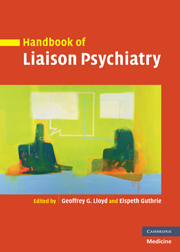Book contents
- Frontmatter
- Contents
- List of contributors
- Preface
- Part I Basic skills
- 1 The development of general hospital psychiatry
- 2 Establishing a service
- 3 Legal and ethical issues in liaison psychiatry
- 4 Understanding psychological reactions to physical illness
- 5 Detection of psychiatric disorders in the general hospital
- 6 The role of the nurse in liaison psychiatry
- Part II Common psychiatric problems across the general hospital
- Part III Working with specific units
- Part IV Treatment
- Part V Different treatment settings
- Index
- References
1 - The development of general hospital psychiatry
from Part I - Basic skills
Published online by Cambridge University Press: 10 December 2009
- Frontmatter
- Contents
- List of contributors
- Preface
- Part I Basic skills
- 1 The development of general hospital psychiatry
- 2 Establishing a service
- 3 Legal and ethical issues in liaison psychiatry
- 4 Understanding psychological reactions to physical illness
- 5 Detection of psychiatric disorders in the general hospital
- 6 The role of the nurse in liaison psychiatry
- Part II Common psychiatric problems across the general hospital
- Part III Working with specific units
- Part IV Treatment
- Part V Different treatment settings
- Index
- References
Summary
General hospital psychiatry is the practice of psychiatry in a particular type of medical setting, whilst liaison psychiatry (the principal focus of this chapter) refers to the clinical expertise and practice relating to psychological and psychiatric problems and treatments in patients presenting to general medical care. Whilst this subject matter has been a part of medicine from the earliest time, its history as a recognized specialist interest is inextricably part of the complicated evolution of psychiatry as a speciality and its at times troubled relationship with the rest of medicine (Shorter 1997). Although now firmly established and expanding, its precise role is uncertain, insecure and misunderstood at least as much within psychiatry as within general medicine. This history cannot be understood as a separate identifiable theme and must be seen as part of the whole social history of medical practice and the rather recent evolution of current patterns of health (Mayou 1989).
This chapter focuses on liaison (or consultation liaison) psychiatry. Although mainly based on historical evidence from the United Kingdom, the central ideas are applicable to the histories of liaison psychiatry in other developed countries. Most other histories of liaison psychiatry have concentrated on North American developments in the last 70 years (Lipowski & Wise 2002; Schwab 1989). Although these have been influential, there is a need for a much more long-term view of the wider relationships between psychiatry and general medicine. The main themes of the chapter can be summarized:
Psychological care has always been implicit in the practice of good medicine.
[…]
Keywords
- Type
- Chapter
- Information
- Handbook of Liaison Psychiatry , pp. 3 - 23Publisher: Cambridge University PressPrint publication year: 2007
References
- 4
- Cited by



